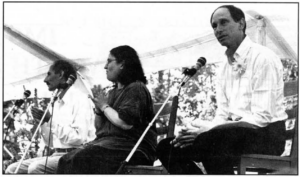On a fine day in August, interrupted only briefly by a dramatic and well-timed thunderstorm, founders, friends and supporters came from far and wide to help celebrate the twentieth anniversary of the Insight Meditation Society.
For me the occasion is laced with nostalgia for an era brimming with innocence, wonder and hope for the world to live as one big human family. The guests, who number close to 400, are predominantly those who came of age in that era. They are joined by handfuls of young adults, kids and old people like me.
Tales told from the podium of early managerial uncertainty at IMS are both touching and amusing. Sharon recounts endless deliberations over whether Buddha statues should be displayed or whether “METTA” should appear over the front door. There were heated debates over the impact of staff sexual behavior upon the silent yogi practice environment. Sharon recalls a yogi statement at the close of a retreat which aptly characterized the operation. “How amazing,” he exclaimed, “that IMS runs without any adult supervision.”
In a more serious vein Jack points to a 1980 teachers’ meeting when the participants told how they each had experienced their deepest realizations. The outpouring was such a palpable expression of love of the dhamma that he knew then “that it would be fine here.”
 Indeed every speaker pays homage to the IMS program. Ram Dass calls it, “a model of clarity and quality which maintains the purity and integrity of the teaching.” Joseph emphasized IMS’s adherence to classical dhamma with these words: “The original teachings are held in a container provided by the West.” Larry Rosenberg calls IMS, “an ingenious invention to get us to sit quietly and learn who we are.” He expresses awe at the vast number of yogis who have come to IMS and sat and walked, sat and walked. Rachel Bagby’s provocative capella vocalization reminds us of the challenging nature of the practice, so simple in its instruction, at times so hard to do. Her haunting notes evoke the experiential range of insight meditation during retreat: “A combination of the deepest gratitude and the dirtiest dukkha“, as she puts it.
Indeed every speaker pays homage to the IMS program. Ram Dass calls it, “a model of clarity and quality which maintains the purity and integrity of the teaching.” Joseph emphasized IMS’s adherence to classical dhamma with these words: “The original teachings are held in a container provided by the West.” Larry Rosenberg calls IMS, “an ingenious invention to get us to sit quietly and learn who we are.” He expresses awe at the vast number of yogis who have come to IMS and sat and walked, sat and walked. Rachel Bagby’s provocative capella vocalization reminds us of the challenging nature of the practice, so simple in its instruction, at times so hard to do. Her haunting notes evoke the experiential range of insight meditation during retreat: “A combination of the deepest gratitude and the dirtiest dukkha“, as she puts it.
In spite of the difficulties of practice, the yogis keep on coming in ever larger numbers. We are told that the demand for IMS retreats is so great courses fill as soon as they are offered. The teachers are being invited to ever more distant places. And the dhamma is spreading to a new generation. Visible evidence of this last development is manifest as four representatives of the Young Adult Course first give their impressions of IMS and then conduct a tree-planting ceremony.
By the time Mirabeau Bush of Seva Foundation runs through an impressive list of field which have been influenced by IMS teaching, I am overwhelmed. My nostalgia has vanished, replaced by deep appreciation for what twenty years have wrought.
The entire celebration is carried along on waves of enthusiasm and joy which do not falter even as afternoon showers pelt the white tents dotting the lawn. There is a giant tent housing the main events, one in which a metta chant is kept alive throughout the day, one for sale of T-shirts and cook books, and a big festive one for the buffet banquet of exquisite Indian food. The luncheon itself is a visual feast, presided over by a Buddha sculpted in ice, cakes mounted on pedestals, gorgeous floral displays and white tablecloths.
The amount of coordination, planning and preparation to pull of this flawless event is impressive. No detail has been overlooked, including a play area for restless kids, overflow parking at the Barre Center for Buddhist Studies with a shuttle bus between the two facilities, a gallery of photos spanning the years (where we see Joseph shaggy and bearded and Jack at his most gaunt). Everybody gets an elegant free Buddha poster. Teams of volunteers assist with every phase, including food preparation and clean-up.
When it is all over, I touch the three knots in the “protection cord” around my throat– a talisman of the moving noontime ceremony conducted by Joseph, Sharon and Jack. Each knot symbolizes a portion of the ritual: Jack’s the three refuges, Joseph’s the precepts and Sharon’s loving-kindness. For a moment I’m immersed in the powerful feelings of tenderness that surged through me as we chanted and tied each other’s cords. Then I laugh out loud as I remember Jack’s tale about Chogyam Trungpa Rimpoche. Someone had asked Trungpa at a similar cord-tying ceremony, “Protection from what?” “From yourself, of course,” came his quick response.
Ah, yes! The ego identity hook, the big danger with which we all grapple. How lucky “I” am for the protection of this practice and this place. My gratitude spills out over the teachers, other yogis, the meditation hall, the walking rooms, even the pots; and I whisper a thousand thank-you as I leave the grounds.